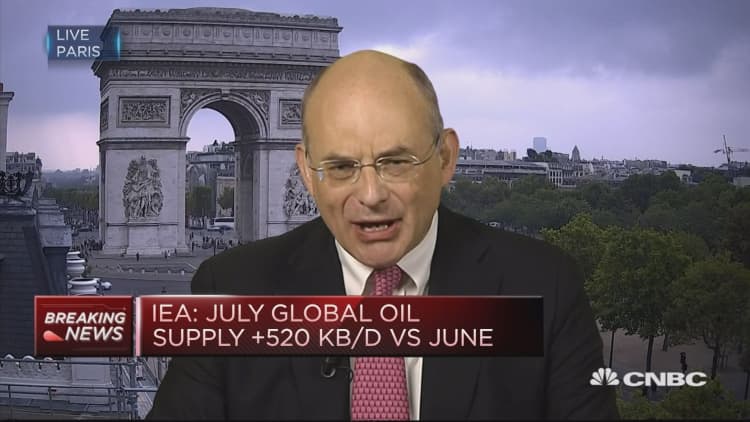U.S. shale drillers will keep posting strong gains in August and September, with production from shale regions topping 6 million barrels a day, the Department of Energy projected.
The department's Energy Information Administration projected output in several key oil producing regions will grow by 117,000 barrels a day to 6.15 million barrels a day in September. The region's output is seen topping 6 million barrels a day in August.
The forecast for this month is significantly higher than a prior estimate, primarily because the EIA began projecting output for the Anadarko region, which covers parts of Oklahoma and Texas, in its August Drilling Productivity Report. Drillers have recently flocked to the Anadarko because the cost of producing oil there is relatively low.
The latest Drilling Productivity Report from EIA marks the sixth straight month the agency has forecast production growth above 100,000 barrels a day.

Oil prices have averaged approximately $49.50 this year, jumping above the key $50 level at times, allowing U.S. drillers to lock in higher prices for future deliveries. That has allowed them to increase output in America's shale regions, where producers rely on expensive drilling methods to free oil and gas from rock formations.
Drillers in Texas and New Mexico's Permian Basin, the center of the shale oil recovery, are on pace to boost drilling by 64,000 barrels a day in September to a total of 2.6 million barrels a day, EIA forecasts.
Output from the Niobrara region underlying northern Colorado and neighboring states is set to rise by 15,000 barrels a day, EIA said. The Eagle Ford region in South Texas is likely to see output rise 14,000 barrels day. The Anadarko and North Dakota's Bakken region are tracking for growth of 12,000 and 10,000 barrels a day, respectively.
The areas surveyed by EIA includes conventional oil wells, so not all of the gains are from shale formations.
Shale worries
Investors have recently grown concerned about the high-growth Permian basin. One of the region's biggest producers, Pioneer Natural Resources, reported its oil wells were producing more associated natural gas than expected, worrying some investors that production could peak sooner than anticipated.
Fellow Permian driller Parsley Energy also reported similar issues and said it lost about 1,000 barrels a day of production in the second quarter due to delays on some wells.
"That just completely caught investors off guard," said Rob Thummel portfolio manager at Tortoise Capital Advisors. "Anybody around and near Pioneer in the Midland basin was impacted."

Shares of Pioneer are down about 18.5 percent since the report on Aug. 1, while Parsley Energy's stock price has fallen nearly 15 percent over the same period.
Some analysts say investors are overreacting to the production issues. Thummel said Tortoise Capital is still a believer in the Permian, and the firm continues to buy shares of producers focused on the region.
Many shale drillers maintained their guidance for 2017 production levels, but some are pulling back spending this year after oil prices softened in the second quarter. That could impact their output growth next year.
WATCH: No clear catalyst pushing oil



